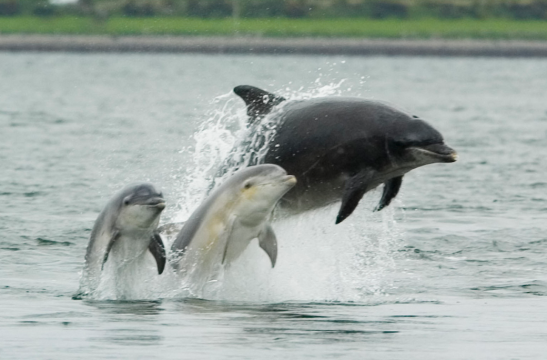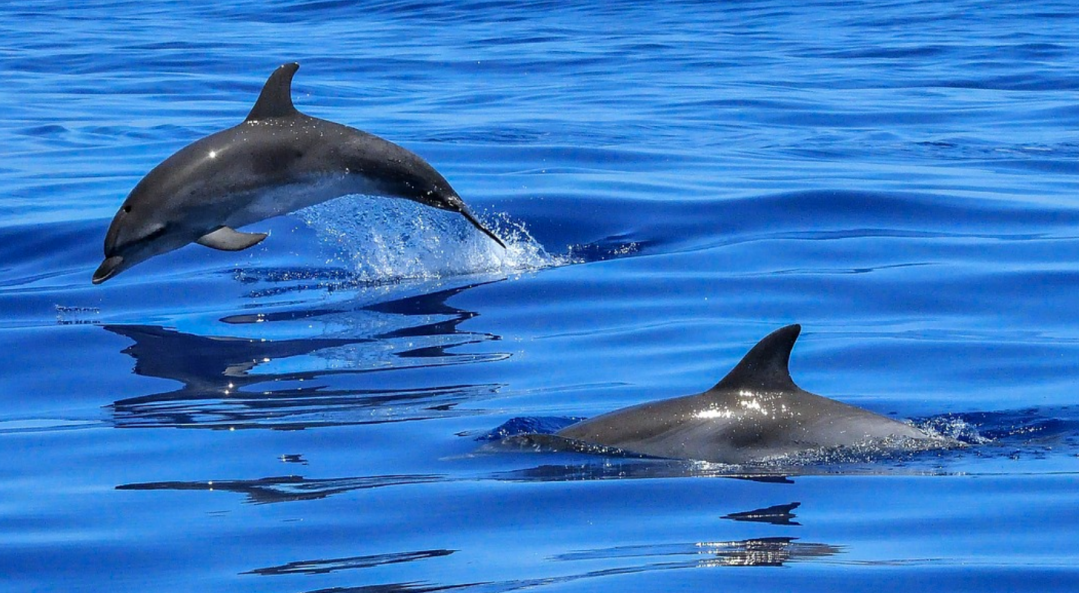“Dolphins” by Pixabay under CC by 2.0
As humans communication is ubiquitous and we have unique ways of communicating whether it be verbal, facial expression, body language or written communication. Between countries, states and even cities communication differs whether is be difference of language or culture. Just like humans, animals communicate in different ways and and differently among different species. Communication is the transmission of information,and there is communication between all living organisms on the planet. Scientist Bradbury & Vehrencamp used the definition: “Communication involves the provision of information (via a signal) by a sender to a receiver, and subsequent use of this information by the receiver in deciding how or whether to respond.” Using this definition, helps to understand that there is a social interaction behavior between sender and receiver. Communication can be conspecific which means it takes places between members of the same species, or heterospecific which is between different species.
How Animals Communicate
Animals communication includes:
- Auditory Signals- Received by hearing
- Chemical Signals- Received by Olfaction
- Mechanical Signals- Received by locomotion
- Electrical Signals- Received by thermoreceptors and electroreceptors
- Optical Signals- Received by light
These signals must benefit the sender and the receiver in order to be adaptive.

“Auditory Communication in Wolves” by Flickr under CC by 2.0
Why Animals Communicate
- Sexual advertisement and mate attraction
- Parental Care (begging, recognition)
- Environmental information (predator alarms, food location)
- Territory defense, conflict resolution
- Social integration (contact calls)
- Predator defense (warning coloration)
Dolphin Communication
Dolphins, specifically Bottle-nose dolphins are found in small close groups consisting of mom and calves or pair-bonded males. They also have causal relationships with dolphins that come and go from other groups. Dolphins are social animals and rely on specific forms of communication between one another. Dolphins typically communicate when they are hunting for food, trying to get another individuals attention, and showing courtship behavior. Their communication can include both verbal and non-verbal cues.

“Bottlenose Dolphin With Young” by Wikimedia Commons under CC by 2.0
Vocal Cues
In water, sound travels 4.5-5 times faster then through air, which dolphins take advantage of. These animals rely on sound more then any other form of communication. There are two different kinds of vocal signals: Pure Tones and Pulsed Sounds.
Pure Tones: Consist of whistles, chirps, and screams. Scientists refer to these as “frequently modulated sounds“, which means that the sound changes with time (rising and falling). Every dolphin has their own unique whistle, which serves as individual identification. Groups of Bottle-nose produce distinct categories of different whistles and use them when they are being social, happy, separated from the group, or panicked. Using these whistles allows them to maintain vocal and physical contact between other dolphins. They respond frequently to other dolphins and researchers are able to distinguish different family groups based off of listening to their calls. Dolphins are able to reproduce even manmade whistles with almost 100% accuracy. Other pure tones such as yelping us used during courtship behavior and when they are under duress, they used pulsed squeaks.
Pulsed Sounds: Consist of clicks. Clicks are brief and occur in rapid succession at regular intervals. A series of clicks is called a “click train”. There are two different kinds of clicks.
- Echolocation Click- Used for sonar purposes and gives them a mental image of objects in their environment. Dolphins make a click and then wait for the echo of that click to return before vocalizing the next one.
- Burst Pulses- Clicks that are released rapidly and do not carry any sonar information. These clicks convey information on their emotional state, such as excited or angry. It is also a play signal. Burst pulse are used when males are trying to heard the females. the pulses are directed to the genital region of the females. These pulses are also used when the mother signals misbehaving calfs. These clicks are all individual sounds, but to the human ear they are heard as a continuous sound.
“Wild Bottleneck Dolphins…” by YouTube under CC by 2.0
Non-Vocal Cues
Even though dolphins primarily communicate using vocal cues, their non-vocal cues are used quite often. Non-Vocal cues include:
- Jaw Claps/Pops– Dolphins clamp their jaws together very rapidly and produce a signal that transmits to a large distance in the water. This behavior is used in aggression signal, threats, and can also occur when playing.
- Chuffs– This is exhaling rapidly through their blowhole when they break the surface. This is also seen as aggression behavior
- Tail/Flipper Slaps– Dolphins hit the surface with their tail which produces a loud boom and transmits sound to a long distance in the water. They also do this by slapping the water or their own bodies with heir pectoral fins. Sounds produce from this behavior signals aggression, that it is time to leave, or trying to get the attention of another individual.
“Tail Slapping” by YouTube under CC by 2.0
- Bubbles– Dolphins release bubbles through their blowholes which makes a whistling sound. When they produce a large bubble, is usually is seen as a threat signal
“Dolphin Bubbles” by YouTube under CC by 2.0
- Breaches– This is when a part or entire body leaves the water and comes crashing into the surface. This produces a loud sound with a low frequency that travels a long distance. This communication method shows emotional or motivation states and allows others to know the position and direction that they are moving.
“Breaches” by YouTube under CC by 2.0
Dolphin communication fascinates researches and there is still so much to learn about these amazing creatures. The Dolphin Communication Project is involved with studying dolphins as well as educating the public and conservation. The Dolphin Research Center promotes a peaceful coexisting communication between animal and human.

I think that this is a really interesting topic! I knew that dolphins had many verbal cues but I did not know of all the non-verbal cues.
LikeLiked by 1 person